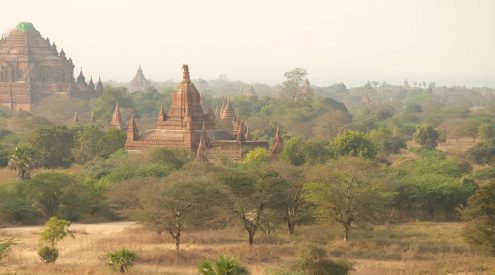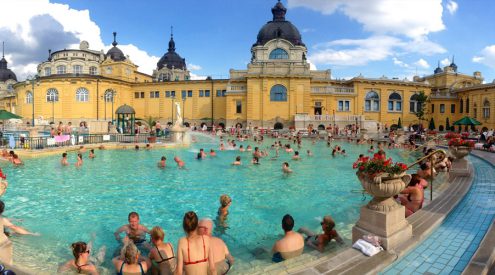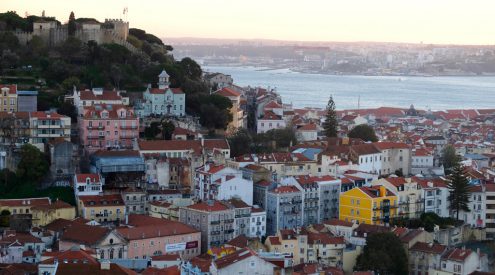The expedition leader warns us at his first briefing that we might as well tear up our official itinerary. Our itinerary will change from day to day because the weather in Antarctica is so unpredictable. L’Austral will go where the good weather and ice takes us – making the journey even more of an adventure. At nightly briefings we are told where we’ll land the next day – as we chase good weather and avoid the ice pack. Two days out of Ushuaia, we are finally ready to make our first landing in the Antarctic.
Reaching the South Shetland Islands, we land at Half Moon Island to visit a huge chinstrap penguin colony – named after the amazing black strap drawn across their chins (like a Vespa scooter helmet). We are lucky to be here during the season when all the furry chicks are only two months old or so – and comically chasing mum and dad all over the shore for food. On a walk to the rookeries, one of the naturalists tells me that the chinstrap is the second most common penguin in Antarctica – with an estimated four million breeding pairs. I wonder how they do a penguin census?
Penguins rule in Antarctica. The sounds and smells are overwhelming. The penguins raise their heads to the skies, stretch out their flippers and bray like donkeys. They rehydrate by chipping ice off the blocks on the seashore – then regurgitate the lot down their hungry chicks’ throats. I’m told every penguin family has a unique call – enabling them all to find each other in these densely populated colonies. It sounds like a mad symphony of a million penguins. The Antarctic turns you into a naturalist overnight.
En route to the north west coast of the Antarctic Peninsula, we’re all out on deck to watch L’Austral negotiates the Gerlache Strait and narrow Nieumeyer Channel off Anvers Island. We make our second landing at Port Lockroy, home of the UK Antarctic Heritage Trust. (Port Lockroy is situated at 64o 49’S, 63o29W’)
Britain’s historic Base A is manned by an all-girl team during the summer season – and hosts up to 15 000 visitors a year. Incredibly, they even take a credit card in the shop where you can buy Antarctic books, stamps and clothing – and even a Lonely Planet Guide to Antarctica. They hand stamp 70 000 postcards a year – and our passports! I leave Antarctica with an albatross, tall ship and a penguin in my passport
We see how the polar teams used to live in Bransfield House in the early 19th century – with a windup gramophone and old Noel Coward records – and all the old tins of food in the pantry. I was amused to see the Antarctic survival cookery book for sale there – with recipes for seal liver, seal brains on toast and penguin eggs. All of these species are protected now – so there are no exotic Antarctic dishes on the menu.
The four women researchers have 800 pairs of breeding Gentoo penguins for company – which nest under the hut and all over tiny Goudier Island – and zillions of kelp gulls. The Gentoo penguins – distinguished by an orange bill and white flash above the eye -are very cute. They were still hatching eggs and keeping their furry new chicks warm buried in fur under their bellies. You have to be really careful where you step. I feel like one of those King Emperor Penguins in the documentary – don’t step on an egg! We walk between red flags planted by naturalists to mark out paths.
Chatting to the German base leader, she tells me she really likes the simplicity of life in Antarctica – the peace and quiet. They send the post off on visiting cruise ships via the Falklands – and take a hot shower aboard a visiting ship every few weeks as a real treat! We could see how suddenly the weather changes in the Antarctic changes – when I go back outside the hut it is snowing heavily and I return alone soaked to ship.
Next we visited Argentina’s Base Brown in Grahamland. I have a place named after me in the Antarctic! We took a zodiac cruise around Paradise Bay – named by the early whalers for its exquisite natural beauty – to get up close to the electric blue icebergs “calved” from the main icebergs. We spotted our first leopard and crabeater seals sunbathing on the surface of small icebergs – and eyeballed them up close from the zodiac. On landing at Base Brown we climb up a hill to a spectacular lookout and body toboggan back down to the base yelling like penguins. In the Antarctic the penguins have right of way – waddling along the ice tunnels through the snow.
We have to turn back at 64o South because the famous Lemaire Channel is still frozen in by ice – an incredible sight as the glittering ice pack slowly surrounded L’Austral. So instead of visiting Port Charcot we head back north via Wilhelmina Bay – where we see a rusty old whaling factory ship, its old rowboats abandoned on the ice a century ago. Under the Antarctic Treaty all the old bases, whaling stations and wrecks are left where they are as part of the frozen continent’s heritage.
L’Austral calls at different sites twice daily for two hours or so, splitting passengers into small groups to minimize the impact on the environment. Getting into and out of all our polar gear twice daily in the lounge – and putting it all on in the right order is quite a mission. I feel like the Michelin man by the time I’m kitted out in three layers of waterproof, thermal clothing! Last of all, my Cape beanie! The excursions vary in terms of landscape, location and activity. We hike up snowy volcanoes to penguin rookeries, cruise around glaciers and icebergs, and visit old whaling stations.
We land in small parties of twelve, so the experience is pretty intimate – often coming ashore with all the happy feet of curious penguins leaping out the water alongside us after a long day foraging for food in the water! I guess that’s how I spend my life too.
We also spotted icebergs, orca whales and seals from the privacy of our own balcony. Out on deck there is always something to see – from albatrosses and orca whales to the electric blue icebergs (baby icebergs are called growlers – there are also “bergies” and the big tubular ones). Standing on the bridge staring at the high-tech array of sonars, radars and computer aids, I’m told L’Austral has a specially reinforced steel hull for the Antarctic – and amazing stabilisers. So I ask the captain whether the story about the tip of the iceberg is true? He quips “There’s no such thing as a small iceberg – they are usually six times bigger underwater – only one seventh is on top.”
In the Antarctic it’s not on top it’s inside, under the surface, way down below.
For expedition itineraries of L’Austral and Compagnie du Ponant around the world, contact their agents in South Africa: Development Promotions – tel 011 442 0822 or see www.devprom.co.za

















